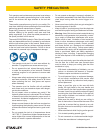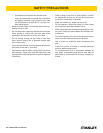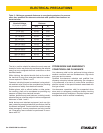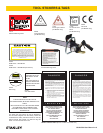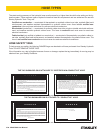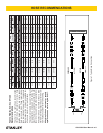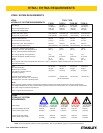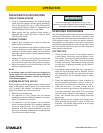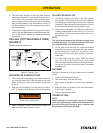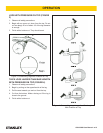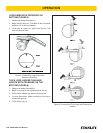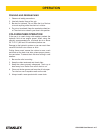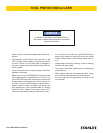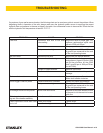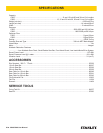
CS05/CS06 User Manual ◄ 13
OPERATING PROCEDURES
The following are general wood cut ting procedures and
techniques. Dif ferences in the terrain, vegetation, and
type of wood will make this infor mation more or less val-
id for particu lar areas. For advice on specic woodcut-
ting problems or techniques for your area, consult your
local Stanley representative or your county agent. They
can often provide infor mation that will make your work
safer and more productive.
CUTTING TIPS
1. Check the lean of the tree. Tie a weight to a piece
of string about 2 feet long. Hang the weight in your
line of sight. The string is a good vertical line to help
you judge the lean of the tree. The tree should fall
the way it is leaning. Trees that are straight (leaning
no more than 5 degrees) gener ally can be felled in
any direction.
2. Avoid felling across another tree, log, rocks, gully or
ridge. Do not fell straight uphill or down hill. Fell the
tree diagonally to the hill. Consider the wind direc-
tion and velocity. Do not attempt cutting in strong
winds.
3. Check the weight distribution. A tree is heavier on
the side with the most limbs. It will try to fall on its
heavy side. Trim a few limbs to “balance” the tree.
4. Clear the work area. You need a clean area all
around the tree for good footing. Get every thing out
of the area where the tree will fall. Do not cut trees
near structures. Because of the danger of electro-
cution, use extreme care when cutting trees near
power lines.
5. Before starting the cut, prepare your escape path.
Make sure the escape path is clear of brush and
branches. The escape path should be at an angle
away from the direction of fall.
PREOPERATION PROCEDURES
CHECK POWER SOURCE
1. Using a calibrated owmeter and pressure gauge,
check that the hydraulic power source develops a
ow of 4-6 gpm/15-23 lpm at 1500-2000 psi/105-
140 bar for the CS05 or a ow of 7-9 gpm/26-34 lpm
at 1000-2000 psi/70-140 bar for the CS06.
2. Make certain that the hydraulic power source is
equipped with a relief valve set to open at 2100 -
2250 psi/145-155 bar.
CONNECT HOSES
1. Wipe all hose couplers with a clean lint-free cloth
before making connections.
2. Connect the hoses from the hydraulic power source
to the tool ttings or quick disconnects. It is good
practice to connect return hoses rst and discon-
nect them last to minimize or avoid trapped pressure
within the tool.
3. Observe the arrow on the couplers to ensure that
the ow is in the proper direction. The female cou-
pler on the tool hose is the inlet (pressure) coupler.
4. Move the hydraulic circuit control valve to the “ON”
position to operate the tool.
NOTE:
If uncoupled hoses are left in the sun, pressure in-
crease inside the hose may make them difcult to
connect. Whenever possible, connect the free ends
of the hoses together.
SYSTEM SELECTION (OC/CC)
Saws congured with the system selector option require
setup for the system, closed-center (CC) or open-center
(CC), in which it will operate. The selector screw is lo-
cated in the bottom end of the valve spool.
1. Determine the system type.
2. For operation in a CC system, turn the selector
screw fully clockwise. When the selector screw bot-
toms, CC operation is selected.
3. For operation in an OC system, turn the selector
screw counter-clockwise until meeting resistance
(from the retaining ring). Turn the selector screw
clockwise and then counter-clockwise to be sure
that you are sensing resistance of the retaining ring.
Do not force the selector screw.
IMPORTANT
To prevent damage to the retaining ring, do not
attempt to force the selector screw counter-clockwise
beyond the point of initial resistance.
OPERATION



